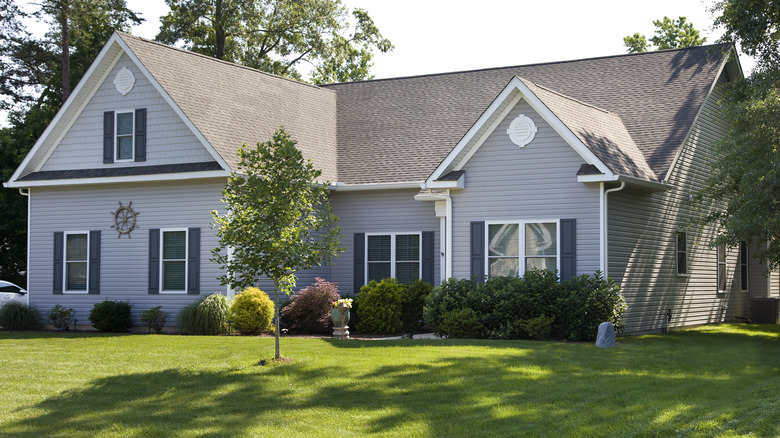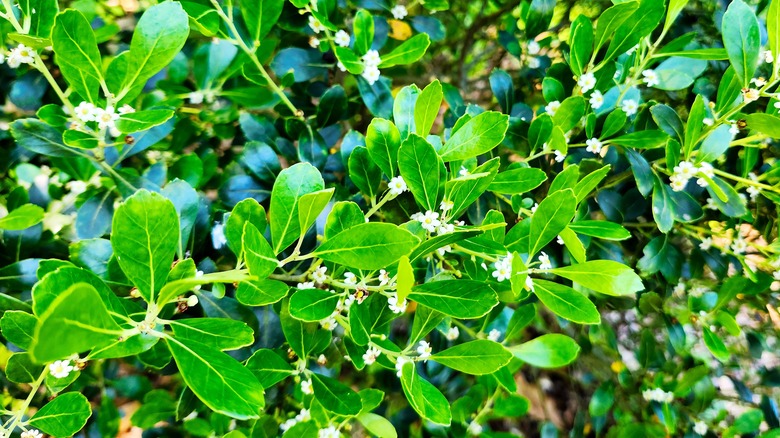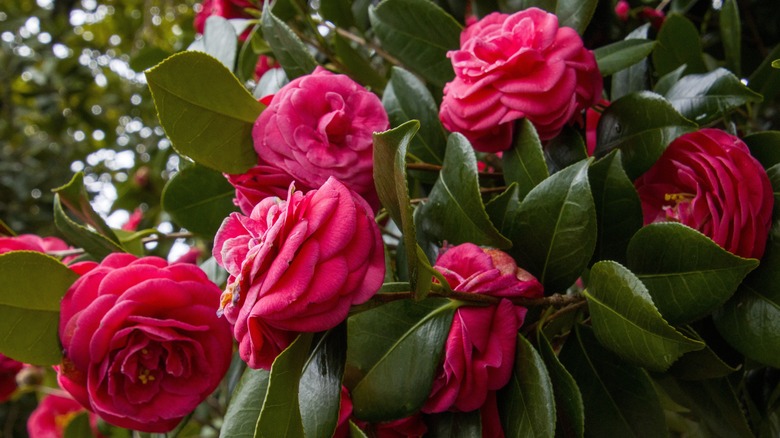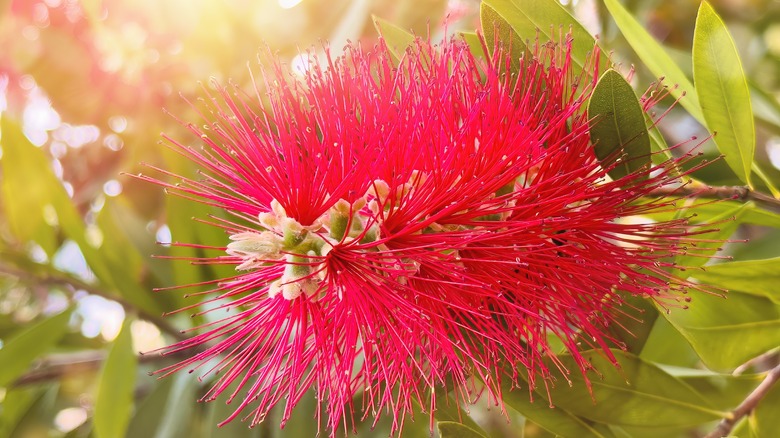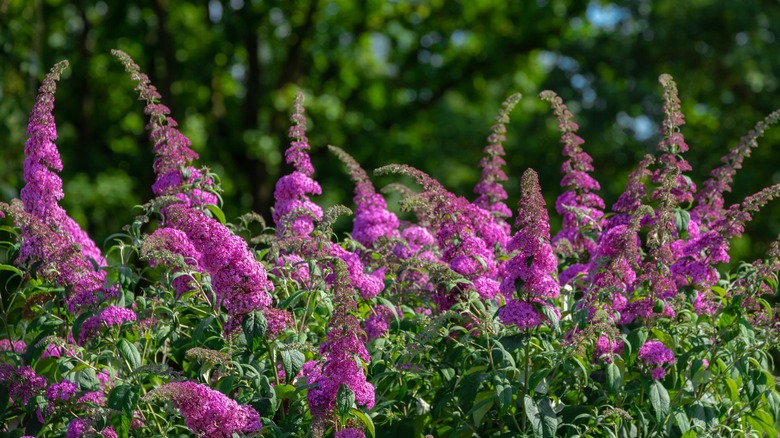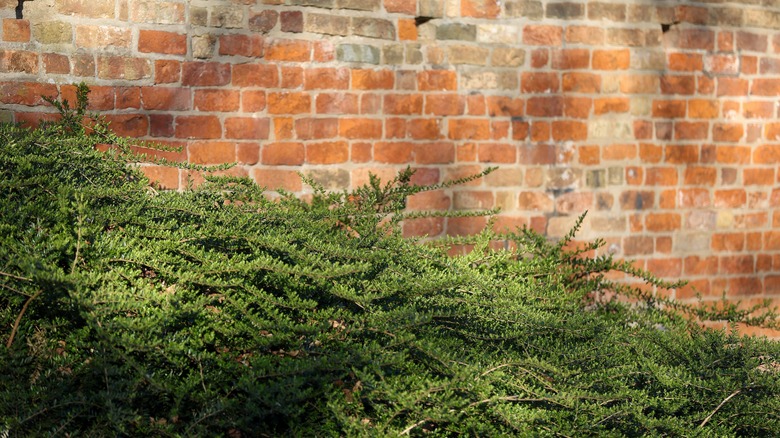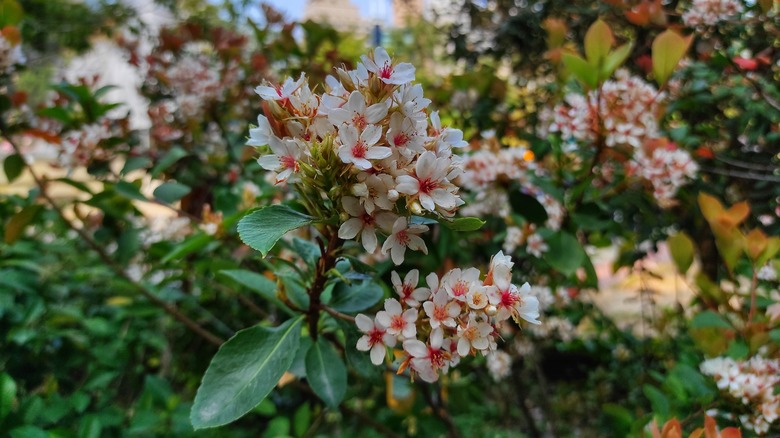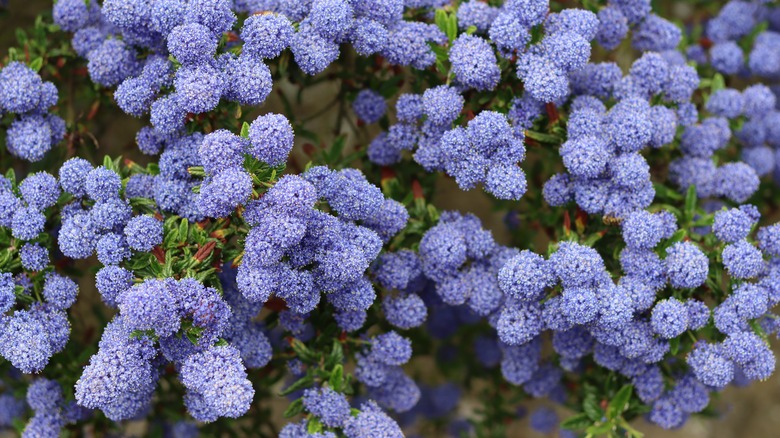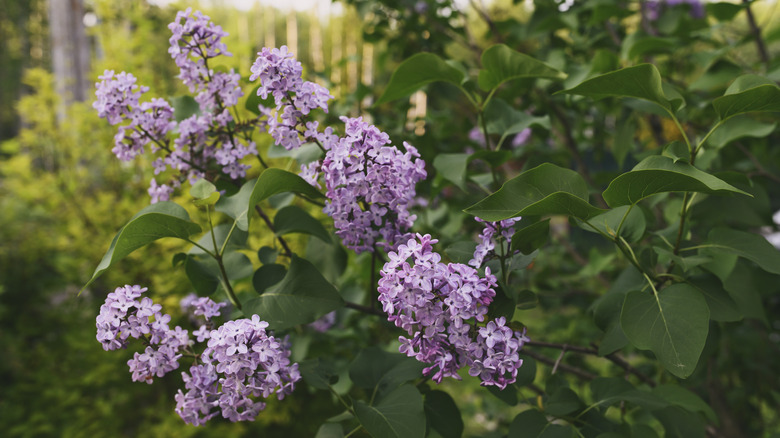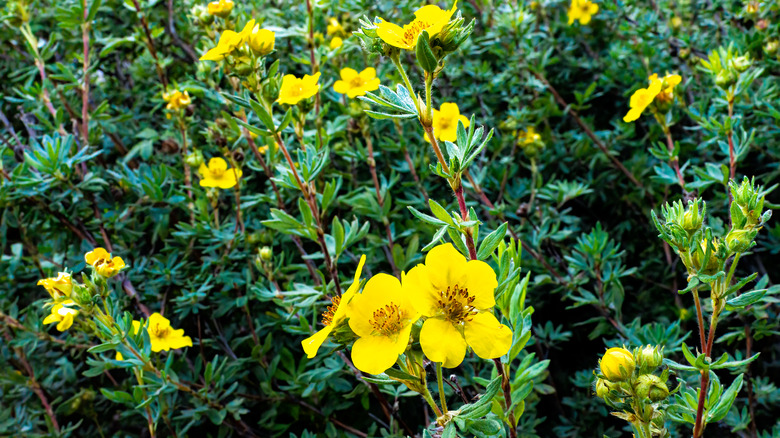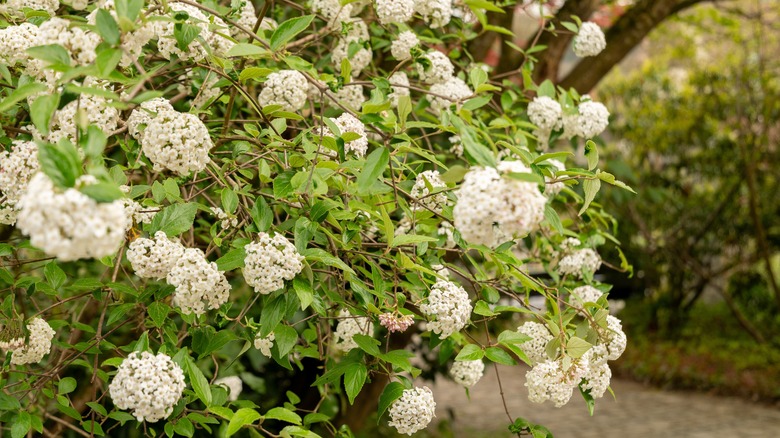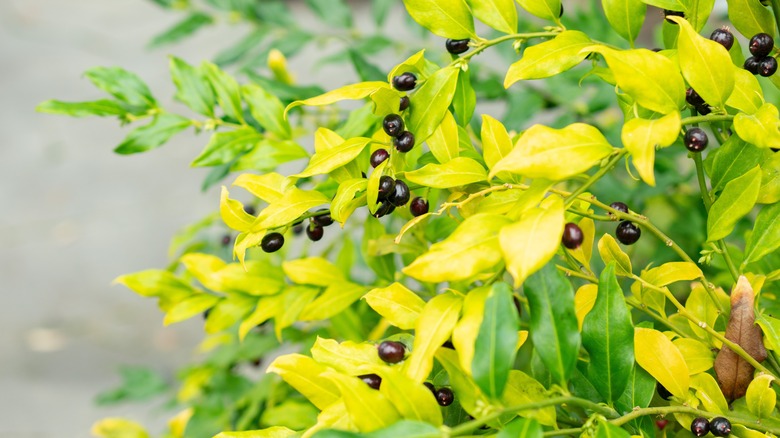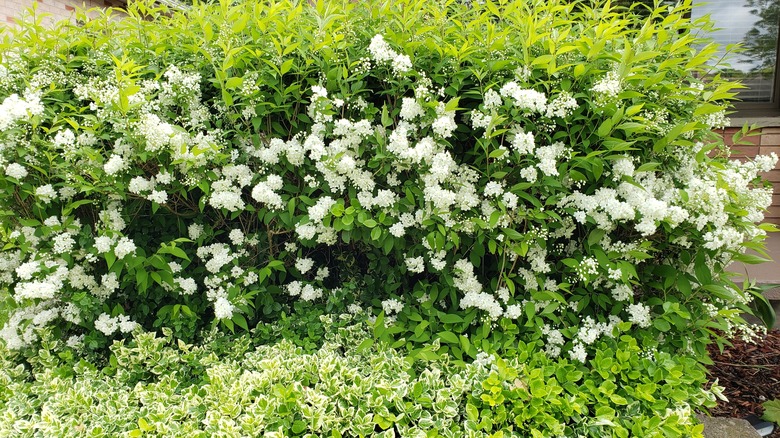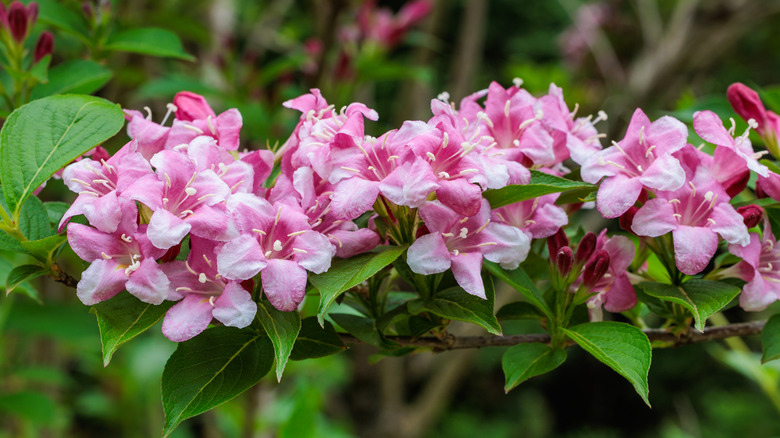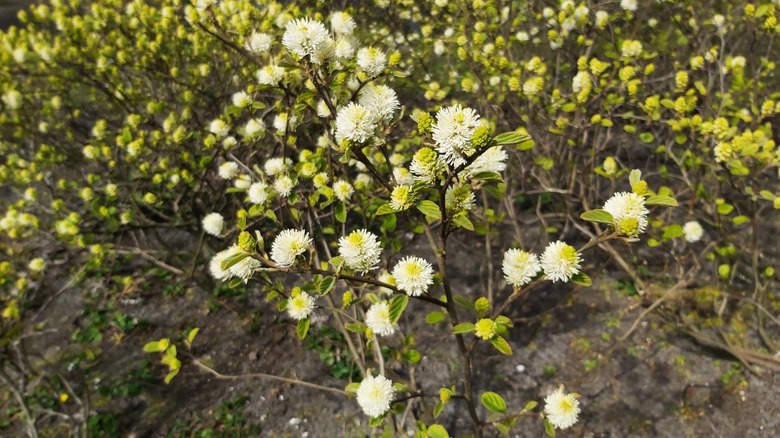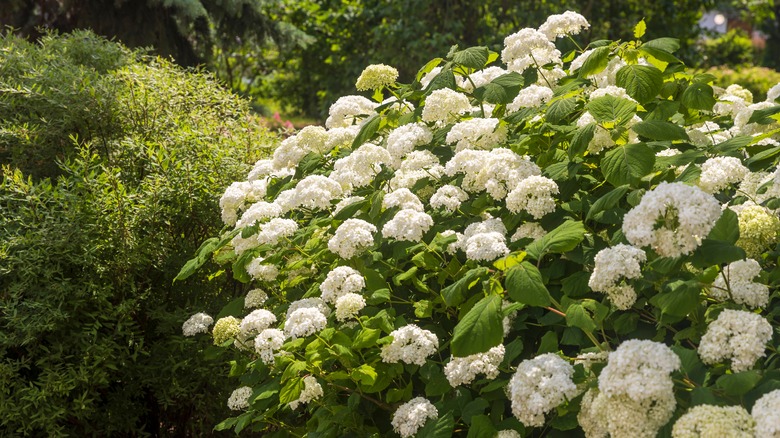21 Hedges And Shrubs That Are Safe For Planting Next To Your House
Plants can make the area around your house look great, but choose the wrong ones, and you might be setting yourself up for some big issues later on. From cracked foundations to mold buildup and even fire risks – plants can cause all of this. Therefore, you need to pick something with non-invasive roots that won't interfere with structural elements. Also, you want shrubs with good airflow to keep mold at bay.
Bonus points if the hedges and shrubs you choose are non-toxic and fire-resistant — you never know when something can go wrong. Some solid choices include dwarf fothergilla (Fothergilla gardenii), black chokeberry (Aronia melanocarpa), 'Blue Star' juniper (Juniperus squamata 'Blue Star'), sweet pepperbush (Clethra alnifolia), and slender deutzia (Deutzia gracilis). However, it's not enough to just pick a safe plant; you also need one that can adjust effortlessly to your climate. So, make sure to check that your shrub or hedge fits your USDA Hardiness Zone (you'll want to double-check this, as your growing zone may have changed.) Also, look up how much sun, fertilizer, and maintenance it will need. In the end, finding a safe shrub and hedge for your house is all about balance: You want to make it look great without having to deal with safety problems later on.
Inkberry
Inkberry (Ilex glabra) is a dense, woody shrub from the holly family. It is known for its branching habit and glossy, evergreen leaves. If you live anywhere in the USDA Hardiness Zones 5 to 9, you can plant it around your home as a hedge or privacy screen. It has mostly small fibrous or woody roots that spread along the rhizome. Only a few roots grow deeper, so you can safely plant it around your home. Plus, its naturally open, leggy shape at the base helps air circulate freely, keeping moisture and mold away from your home's foundation.
Littleleaf boxwood
Littleleaf boxwood (Buxus microphylla) is the perfect evergreen shrub for drought-prone areas. And since it has shallow roots, you don't have to worry about any damage when planting it right next to your home. Furthermore, it only has moderate flammability, and boxwood species are usually listed as a good option as fire-wise shrubs. If you live in zones 6 to 9, it can be a good choice as a hedge or border shrub. Just keep in mind that it grows slowly.
Camellia
If you are looking for a tall, evergreen broadleaf shrub, camellia (Camellia japonica) is the one you want. It grows to about 10 to 13 feet in height and can thrive anywhere in zones 7 to 9. What makes it safe for planting next to your house is its shallow root systems that stay close to the ground, so it won't damage your walls or foundations. Also, it has low flammability and doesn't present any significant fire risk. Just make sure you plant it in loose and acidic soils with a pH of about 5.5.
Crimson bottlebrush
Another tall, broadleaf evergreen, perennial shrub — crimson bottlebrush (Melaleuca citrina) is a commonly used hedge. However, you can train it to stay 3 to 5 feet tall if you want to use it as a border and accent plant alongside your home. Its leaves have low to moderate flammability, and relatively shallow root systems compared to many other shrubs. Lastly, crimson bottlebrush is non-toxic to cats and dogs, making it a wonderfully safe shrub for homes with pets. For best results, plant it in zones 9 to 11.
Summer lilac
Also known as butterfly bush, summer lilac (Buddleia davidii) is the semi-evergreen shrub you need if you want something that grows fast, has showy flowers, and smells amazing. It has shallow, fibrous roots and a low flammability rating, too, making it an ideal choice to plant next to homes and foundations. This shrub can handle winters in zones 5 to 9, although if you're in zones 5 or 6, expect it to die back to the ground during winter. It can survive in most normal soils, but needs plenty of sun.
Box honeysuckle
Box honeysuckle (Lonicera nitida) is an evergreen shrub, growing to about 4 to 5 feet tall, with glossy green leaves. It is often planted in groups to form neat, formal hedges along borders and verges. What makes it safe to grow next to your house is that many honeysuckle bushes have shallow roots, so they won't interfere with or damage any foundations or underground pipes. It's also often a suggested plant in bushfire-prone areas. You can grow it anywhere in zones 6 to 9; just keep it well-pruned to avoid a messy growth habit.
Indian hawthorn
If your space is tight, Indian hawthorn (Raphiolepis spp.) is the shrub you want. This compact, slow-growing shrub works beautifully in foundation plantings, with small, white to pink crabapple-like flowers from April to May. Furthermore, it has some fire resistance and is not very flammable. You also don't have to worry about it being toxic to pets or kids, which makes it even safer when used around homes. You can grow it anywhere in zones 8 to 10. Since it grows low, you won't have problems with its roots either.
California lilac
California lilacs (Ceanothus x pallidus) grow as loosely branched, broadly mounded shrubs with a graceful shape. They grow well in zones 6 to 8. And, if you are looking for a foundation plant that is not a fire hazard, California lilac is a good choice, as it does not readily or easily catch on fire. Also, since it is not toxic, you can safely plant it next to your house even if you have kids or pets. Just make sure you put them in well-drained rocky or sandy soils where they thrive.
Black chokeberry
Black chokeberry (Aronia melanocarpa) is a versatile shrub that works well for mass plantings, hedges, or along pond edges. It has a shallow root system, about 6 inches to 1-foot-deep, so you can plant without worrying about getting your foundation damaged. Furthermore, it is not very prone to igniting and can be planted in zones 3 to 8 as a fire-resistant landscape plant. Even better, these shrubs are non-toxic to pets and kids. Just don't let them munch too much, though, if you want to avoid stomach discomfort.
Japanese pittosporum
Japanese pittosporum (Pittosporum tobira) is one of the best hedges you can plant for privacy in your yard. It performs best in zones 8 to 10, grows fast, and reaches heights of up to 13 feet. However, it can stand heavy pruning if you want to keep it compact. Its roots are usually not a problem, and it has low flammability. Furthermore, it is non-toxic. Even though it grows densely, you can prune it heavily if you ever notice moisture buildup around the siding of your house.
Rose-of-Sharon
Rose-of-Sharon (Hibiscus syriacus) is a narrow shrub valued for its abundant blooms and use as a hedge. Its branches are loose and open, so it won't create airflow restrictions and resulting problems like mold buildup on home walls. Furthermore, several of its roots are right under the ground surface, so it definitely won't be a problem for foundations or any other structural elements. Lastly, it has no toxic properties and is fire-resistant. You can plant several together, spacing them about 6 to 12 feet apart to form a hedge in moist, well-drained but not overly wet soil.
Common lilac
An old-fashioned shrub, common lilac (Syringa vulgaris), makes an excellent hedge and a border plant. You can plant it anywhere in zones 3 to 7 — just keep it out of poorly drained and highly acidic soils. What makes it a safe choice for planting alongside houses is that its roots are shallow, so there is little risk of damage to foundations. Also, it is a good choice when it comes to selecting fire-wise plants around your home. And since its flowers can be eaten, you don't have to worry about toxicity either.
Shrubby cinquefoil
Shrubby cinquefoil (Potentilla fruticose) is a small perennial plant with tiny, bright yellow flowers that can be used to create a low hedge near homes. It has a shallow to moderately deep root system, so it won't be much of a problem for structural elements. Furthermore, it has good fire resistance, and you can plant it anywhere in zones 2 through 7. While you can plant it in shade, for more blooms, choose a spot with plenty of sunlight. Other than that, it is not fussy and grows easily.
Pineapple guava
If you are looking for a food-producing shrub that can also be used as a hedge, pineapple guava (Acca sellowiana) is definitely the one you want along your house. It is evergreen, and if you prune it consistently, it will become rather loose, which is definitely a good thing in moist areas where mold can be an issue. You can grow it anywhere in zones 8 to 10 if you just provide it with consistent soil moisture (especially if you want its fruit). Other than that, it is fire-resistant and has beautiful, edible flowers.
Burkwood viburnum
Burkwood viburnum (Viburnum x burkwoodii) is a large, easy-to-grow shrub that can be used as a hedge or a foundation plant. And since viburnums are shallow-rooted plants, you don't have to worry about any damage to your house. To add to its safety, burkwood viburnum is also a fire-resistant plant and has an open growth habit. This will allow for unrestricted airflow even when you put it close to your wall, and avoid problems like moisture buildup and mold. You can plant it anywhere in zones 4 to 8 with well-drained soil.
Sweet box
Sweet box (Sarcococca confusa) is a bushy, broadleaf evergreen shrub that can also be used as a hedge. It grows well in zones 6 to 9 and prefers moist but well-drained soil. Since it has a fibrous root system, you can plant it without worry near your house. Furthermore, it is not very flammable and has no toxic effects.You can plant it in shade or sun — ideally somewhere where you can appreciate its fragrance.
Slender deutzia
If you are looking for a formal hedge or foundation plant with beautiful white flowers, slender deutzia (Deutzia gracilis) is the one you want to go for. What makes it safe as a landscaping plant is its low flammability and non-toxic properties. Furthermore, since it is used in foundation planting, you don't have to fear that it will interfere with structural elements around your house. For it to thrive, plant it in zones 5 to 8, and make sure it gets full sun. Be sure to prune it regularly, or it will look very unkempt.
Weigela
Looking for a deer-resistant shrub, hardy in zones 4 to 8, with beautiful flowers that can be used as a hedge? Then you should choose weigela (Weigela florida). It is one of the most gorgeous flowering shrubs that will make a perfect foundation plant for your home. Why? Because it has a shallow root system, it is relatively resistant to fire, and it is not toxic at all. That said, it grows dense, but it responds well to pruning in case you are worried about moisture buildup and mold.
Dwarf fothergilla
Dwarf fothergilla (Fothergilla gardenii) is a slow-growing deciduous shrub, perfect for grouping in clusters to form a casual, low hedge. It likes moist, well-drained, acidic soil with plenty of organic matter. For best results, grow it in full sun to part shade in zones 5 to 8. Dwarf fothergilla has a shallow root system and is fire-resistant, so you can plant it safely right next to your house. It's also considered non-toxic to both humans and pets, which makes it a safe choice for families with kids or animals around.
Smooth hydrangea
Smooth hydrangea, or wild hydrangea (Hydrangea arborescens), is a loosely branched, wide-spreading deciduous shrub. It grows best in zones 3 to 9, and since it has a shallow root system, you can put it right next to your home without worry. Also, it is a good firewise choice for safe landscapes, and can be used as a low hedge. Smooth hydrangeas are adaptable to many conditions, but don't tolerate drought very well.
Summersweet clethra
If you want a hedge that attracts butterflies and songbirds, summersweet clethra (Clethra alnifolia) is the one you should go with. It can be planted anywhere in zones 3 to 9, and prefers rich soil that is acidic and moist. What makes it a safe choice for planting alongside houses is its low flammability and shallow root system. Furthermore, it has no known toxicity attributes, so you can grow it safely even if you have kids or pets. People like this because it keeps flowering even in the shade (something most other plants can't manage).
